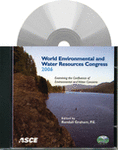Channel Restoration Design of Deadman's Run Tributary: An Application of Tractive Shear Analysis and Regime Methodology
Publication: World Environmental and Water Resource Congress 2006: Examining the Confluence of Environmental and Water Concerns
Abstract
The Deadman's Run Tributary, located in Lincoln, Nebraska, was channelized and has since been subjected to more than forty years of extensive repairs using conventional hard armor methods. These methods have been largely ineffective at addressing the underlying cause of widespread bank erosion: channel incision. The existing channel bed slope is more than an order of magnitude higher than what is customary for undisturbed regional streams. It is anticipated that, if left to its own devices, the tributary channel would continue to erode and eventually re-construct a sinuous channel inside an entrenched floodplain. To address the severe erosion problems along the tributary, project stakeholders including the City of Lincoln, The Lower Platte South Natural Resource District and the University of Nebraska, Lincoln, retained the design team of The Schemmer Associates, Inc. and Intuition & Logic to provide analysis and channel restoration design. Our objective was to restore dynamic equilibrium to the tributary based on the current hydrologic regime and restore a stable meandering planform. Design requirements included a low-flow channel that would accommodate the stream-forming flow and a flood channel capable of conveying the 1-percent recurrence flow. An additional challenge to the design was the close proximity of the upper tributary reach to University research orchards. Recent publications provide a number of design methodologies for channel restoration. This paper presents a method used for the restoration design of Deadman's Run Tributary; a combined approach of tractive shear analysis and regime methodology, based on the planform geometry equations from Soar et al. To avoid a uniform planform appearance, a range of acceptable planform geometries was developed by varying channel sinuosity using the Meander Pattern 4.1 STREAM module, developed by the Ohio Department of Natural Resources and Ohio State University. The resulting variability in meander length, amplitude, and radius of curvature introduced an organic component to the design and, thus, more closely approximated the aesthetic of a natural meandering stream.
Get full access to this chapter
View all available purchase options and get full access to this chapter.
Information & Authors
Information
Published In
Copyright
© 2006 American Society of Civil Engineers.
History
Published online: Apr 26, 2012
ASCE Technical Topics:
- Channel stabilization
- Channels (waterway)
- Colleges and universities
- Design (by type)
- Ecological restoration
- Ecosystems
- Education
- Engineering fundamentals
- Environmental engineering
- Erosion
- Geology
- Geotechnical engineering
- Hydraulic design
- Hydraulic engineering
- Hydraulic structures
- Practice and Profession
- River engineering
- Rivers and streams
- Stream channels
- Water and water resources
- Waterways
Authors
Metrics & Citations
Metrics
Citations
Download citation
If you have the appropriate software installed, you can download article citation data to the citation manager of your choice. Simply select your manager software from the list below and click Download.
